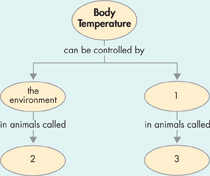28 Study Guide
 Structure and Function
Structure and Function
Nervous systems collect and process information from the environment and coordinate the responses of muscular, endocrine, immune, and reproductive systems, so that animals can maintain homeostasis and reproduce.
28.1 Response
 When an animal responds to a stimulus, body systems work together to generate a response.
When an animal responds to a stimulus, body systems work together to generate a response.
 Animal nervous systems exhibit different degrees of cephalization and specialization.
Animal nervous systems exhibit different degrees of cephalization and specialization.
 Sensory systems range from individual sensory neurons to sense organs.
Sensory systems range from individual sensory neurons to sense organs.
28.2 Movement and Support
 Animals have three main kinds of skeletal systems: hydrostatic skeletons, exoskeletons, and endoskeletons.
Animals have three main kinds of skeletal systems: hydrostatic skeletons, exoskeletons, and endoskeletons.
 In many animals, muscles work together in pairs or groups that are attached to different parts of a supporting skeleton.
In many animals, muscles work together in pairs or groups that are attached to different parts of a supporting skeleton.
28.3 Reproduction
 Asexual reproduction requires only one parent, so individuals may reproduce rapidly. But offspring produced asexually have less genetic diversity than do offspring produced sexually. Sexual reproduction maintains genetic diversity in a population by creating individuals with new combinations of genes.
Asexual reproduction requires only one parent, so individuals may reproduce rapidly. But offspring produced asexually have less genetic diversity than do offspring produced sexually. Sexual reproduction maintains genetic diversity in a population by creating individuals with new combinations of genes.
 During internal fertilization, eggs are fertilized inside the body of the egg-producing individual. During external fertilization, eggs are fertilized outside the body.
During internal fertilization, eggs are fertilized inside the body of the egg-producing individual. During external fertilization, eggs are fertilized outside the body.
 Animals may be oviparous, ovoviviparous, or viviparous.
Animals may be oviparous, ovoviviparous, or viviparous.

 Reptiles, birds, and a few mammals have evolved amniotic eggs in which an embryo can develop without drying out. Mammals differ greatly in their means of reproduction and development, but all nourish their young with mother's milk.
Reptiles, birds, and a few mammals have evolved amniotic eggs in which an embryo can develop without drying out. Mammals differ greatly in their means of reproduction and development, but all nourish their young with mother's milk.
28.4 Homeostasis
 All body systems work together to maintain homeostasis.
All body systems work together to maintain homeostasis.
 Most reptiles, invertebrates, fishes, and amphibians are ectotherms that regulate body temperature primarily by picking up heat from, or losing heat to, their environment. Endotherms, such as birds and mammals, have high metabolic rates that generate heat, even when they are resting.
Most reptiles, invertebrates, fishes, and amphibians are ectotherms that regulate body temperature primarily by picking up heat from, or losing heat to, their environment. Endotherms, such as birds and mammals, have high metabolic rates that generate heat, even when they are resting.
Think Visually Fill in the following concept map.
Table of Contents
- Formulas and Equations
- Applying Formulas and Equations
- Mean, Median, and Mode
- Estimation
- Using Measurements in Calculations
- Effects of Measurement Errors
- Accuracy
- Precision
- Comparing Accuracy and Precision
- Significant Figures
- Calculating With Significant Figures
- Scientific Notation
- Calculating With Scientific Notation
- Dimensional Analysis
- Applying Dimensional Analysis





